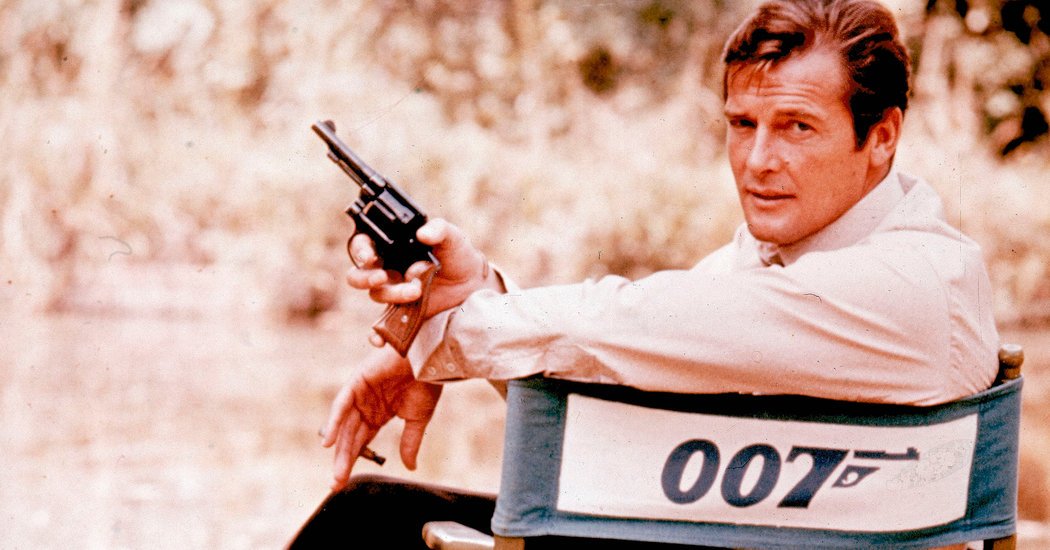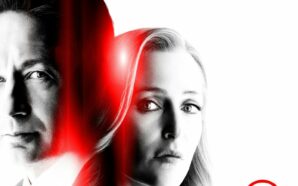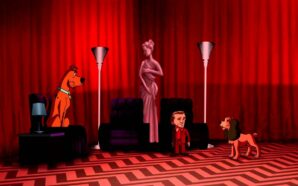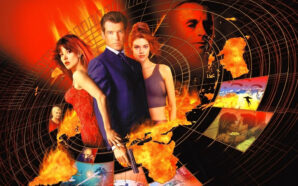When I was growing up, Roger Moore was my James Bond. Even though Brosnan was still Bond when I became a fan, I was enamoured with the light-hearted romps of Moore’s Bond; a more jovial character than the other incarnations while being no less a spy. But times change. During my recent rewatch of the James Bond series, I’ve gravitated towards the more serious Bond films and discovered a newfound love for both Connery and the more controversial Lazenby. So, how will the Roger Moore films I cherished so much as a child stand up after all these years? Is the legacy of Moore’s Bond as a camp and overly-silly spy correct or is there more going on? Over the past few weeks I’ve rewatched all seven of his films for the first time in years to see just how Moore’s films have aged in comparison to both the other Bond films and my memories of them.
Live and Let Die (1973)
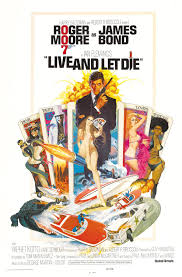 There was a time when I would say Live and Let Die was my favourite Bond film. Now, I’m not even sure if it is a Bond film. On one hand the film is an obvious attempt to be Moore’s version of Dr No. That film worked well as an introduction of Connery’s version of James Bond and so elements are copied to reintroduce the character and get the audience familiar with Moore’s Bond in an accessible way. Just like in Dr No, the film has a Caribbean setting, an island people dare not tread, an ally of James called Quarrel (supposedly the son of Dr No’s Quarrel despite looking 10 years older) and instead of a spider in the bed, there’s a snake in the bath. And yet, for large periods of time, it doesn’t feel like a Bond film at all. The success of Dirty Harry means that Bond has done away with his Walther PPK and has a Smith and Wesson instead. The film dabbles in the ethnic subgenre of Blaxploitation; the villains no longer being world-dominating megalomaniacs but instead drug dealers in pimpmobiles. Live and Let Die is also the only Bond film to take a supernatural angle with the villainous Baron Samedi seemingly being immortal and Bond girl Solitaire is able to use Tarot cards to see the future, until Bond sleeps with her that is. It’s as if the producers are trying out new directions for the franchise while at the same time trying to harken back to the first Bond film. It doesn’t quite work and makes the film feel schizophrenic.
There was a time when I would say Live and Let Die was my favourite Bond film. Now, I’m not even sure if it is a Bond film. On one hand the film is an obvious attempt to be Moore’s version of Dr No. That film worked well as an introduction of Connery’s version of James Bond and so elements are copied to reintroduce the character and get the audience familiar with Moore’s Bond in an accessible way. Just like in Dr No, the film has a Caribbean setting, an island people dare not tread, an ally of James called Quarrel (supposedly the son of Dr No’s Quarrel despite looking 10 years older) and instead of a spider in the bed, there’s a snake in the bath. And yet, for large periods of time, it doesn’t feel like a Bond film at all. The success of Dirty Harry means that Bond has done away with his Walther PPK and has a Smith and Wesson instead. The film dabbles in the ethnic subgenre of Blaxploitation; the villains no longer being world-dominating megalomaniacs but instead drug dealers in pimpmobiles. Live and Let Die is also the only Bond film to take a supernatural angle with the villainous Baron Samedi seemingly being immortal and Bond girl Solitaire is able to use Tarot cards to see the future, until Bond sleeps with her that is. It’s as if the producers are trying out new directions for the franchise while at the same time trying to harken back to the first Bond film. It doesn’t quite work and makes the film feel schizophrenic.
I do think the film is a pretty good showing and introduction for Roger Moore as James Bond. Bond isn’t in the pre-credits opening, building anticipation in the audience who are eagerly waiting to see the latest incarnation of the character. From his first scene, Moore’s Bond is a more romanticised secret agent than previous versions and while the script calls for him to be brutal at times, it’s clear already he’s not that kind of Bond. The plot is pretty thin and sees Bond on the trail of both Kananga, the corrupt leader of fictional island San Monique, and Mr Big, a fast-talking drug-dealing New Yorker, and soon finds out that they are one and the same. The plot gives way about half-way through and the film becomes one chase scene after another from foot to bus to plane to boat. The boat chase, while fun, is far too long and features Sheriff JW Pepper, a character I can’t work out if I love, like, dislike or hate. One character I most definitely hate is Rosie Carver, one of the worst characters in all 24 films. She’s both a CIA agent and a secret agent for Kananga and absolutely awful at both, doing nothing but scream before she finally dies. Live and Let Die was one of my favourite Bond films as a kid but now I just don’t think it works. It is fun to watch but the differing aspects the film is going for never feel cohesive.
The Man with the Golden Gun (1974)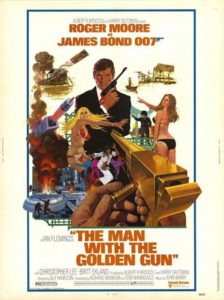
The film where Roger Moore’s kissing technique begins to resemble sucking out the soul. Which is apt really considering he’s sharing screen time with Dracula. Christopher Lee portrays Scaramanga, the world’s deadliest assassin, who’s tracking Bond across Asia and trying to stop him from obtaining the “Solex Agitator”, a MacGuffin that converts solar energy into usable power. I’m not sure the Agitator storyline was necessary because The World’s Greatest Spy vs The World’s Deadliest Assassin is a concept worthy of being an entire film itself. What we get with Scaramanga is fantastic, we just don’t get enough of it. Despite the general lack of screen time, Christopher Lee gives a fantastic performance and his best moment comes when he’s caressing Miss Anders, his mistress, with the barrel of his gun. A scene brimming with untapped disturbing potential but the film doesn’t go in those directions. Instead it’s annoyingly light and comedic.
The opening sequence is similar to From Russia with Love, following the main antagonist on a training exercise to show how deadly he is. While that film used the scene to introduce the dark and serious tone by setting it in a creepy hedge maze, The Man with the Golden Gun’s opening is set in a half circus/half waxwork museum which sets a silly tone that continues for the entire running time. Moore is having fun but there’s a little too much wry smirking and eyebrow-raising for my taste and the final fight scene is painful to watch. Bond has to fight Scaramanga’s henchman Nick Nack, a little person, and it’s just so ridiculous. Bond has to bat away wine bottles with a chair leg, chase him under a table and eventually trap him in a luggage case, all while flippant music plays. The film is also embarrassingly trying to tap into the zeitgeist and copy elements from other successful films. There’s plenty of Kung-Fu and a moment copied from Raiders of the Lost Ark where Bond just kicks a baddie in the face after he performs an elaborate pre-fight display. The most egregious example of both the silly tone and trying to capture the zeitgeist comes in the form of an Evel Knievel-style stunt. It’s one of the greatest stunts ever filmed and the film ruins the moment by putting a slide whistle sound effect over it. It’s a microcosm for the whole film. The Man with the Golden Gun is a film you can have fun with but overall it’s a disappointing entry of the Bond canon. However, I would love to see a modern version of Scaramanga in a future film which lives up to the promise of the Bond vs The World’s Deadliest Assassin concept.
The Spy Who Loved Me (1977)
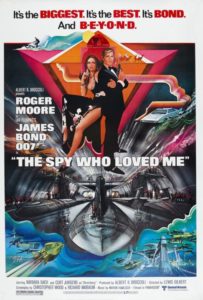 After a couple of questionable entries in franchise, we now come to Roger Moore’s definitive Bond film. When I think of Roger Moore, no scratch that, when I think of James Bond this is the film and performance I think of. The Spy Who Loved Me finds Bond having to team up with Agent XXX, not Vin Diesel but Bond’s Russian female counterpart, and they uncover the villainous plans of Stromberg, a megalomaniac who wants to start WW3 and survive by living under the sea. Triple-X is one of the best Bond girls to date because her character is actually interesting and capable. Not exactly by today’s standards for a woman in an action movie (she still has to hire bodyguards in one scene) but it’s a big step in the right direction, even if “actress” Barbara Bach can’t act in the slightest. Her and Bond’s relationship and back-and-forth is the highlight of the film; enemies turned partners with the constant threat of them turning on one another, before learning to trust each other while still having a competitive edge. The same translates to when M meets his Russian counterpart Gogol, which is one of my favourite scenes in the franchise.
After a couple of questionable entries in franchise, we now come to Roger Moore’s definitive Bond film. When I think of Roger Moore, no scratch that, when I think of James Bond this is the film and performance I think of. The Spy Who Loved Me finds Bond having to team up with Agent XXX, not Vin Diesel but Bond’s Russian female counterpart, and they uncover the villainous plans of Stromberg, a megalomaniac who wants to start WW3 and survive by living under the sea. Triple-X is one of the best Bond girls to date because her character is actually interesting and capable. Not exactly by today’s standards for a woman in an action movie (she still has to hire bodyguards in one scene) but it’s a big step in the right direction, even if “actress” Barbara Bach can’t act in the slightest. Her and Bond’s relationship and back-and-forth is the highlight of the film; enemies turned partners with the constant threat of them turning on one another, before learning to trust each other while still having a competitive edge. The same translates to when M meets his Russian counterpart Gogol, which is one of my favourite scenes in the franchise.
My only complaint is that Stromberg could have been a stronger villain. It would have been better if he was replaced by Blofeld but they couldn’t use that character any longer because of rights issues. Luckily, we have the best henchman in Bond history to make up for it: Jaws. A great big hulking man with metal teeth and a taste for neck flesh, he’s reminiscent of an old school Universal Monsters villain and shot like one too. Roger Moore puts in the perfect performance here, balancing Bond as an action hero in the spectacular third act (filmed in one of the best sets ever produced) and genuine comedy which offers many more laughs than cringe moments, although there are still a few. The music is incredible and is my favourite non-John Barry score while Lewis Gilbert’s direction is sublime, transcending what you could say is a pastiche of You Only Live Twice and turning it into something special. And while I’ve always been an Aston Martin fan, there’s no denying how iconic and amazing the submersible Lotus is. The Spy Who Loved Me is as important to the franchise as Goldfinger, setting a formula that will be used, and abused, by future Bond films for decades. But casting aside that legacy, it’s just an incredible film. Moore’s best and maybe even the best Bond film period.
Moonraker (1979)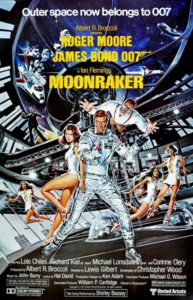
The film where a pigeon does a double take. Everything that The Spy Who Loved Me got right, Moonraker gets wrong. They’re shockingly similar films in terms of plot: Hugo Drax is the genocidal megalomaniac this time around and while Stromberg wanted to destroy the human race whilst he lived the good life under the sea, Drax has the exact same plan except he’s retreating to space, along with his selected few ‘perfect’ people, ready to return to Earth when the dust has settled. Bond has to team up with a female agent from a rival agency (sound familiar) to stop him. The end credits of The Spy Who Loved Me states that “James Bond will return in For Your Eyes Only” but with the huge success of Star Wars in 1977 those plans were delayed and, once again trying to keep Bond in the cultural zeitgeist, Moonraker was rushed into production. The rushed production is clear from the outset, not only in the copy and pasted script, but the entire film just feels… off somehow. The tone is all over the place, going from a woman being torn to shreds by hungry dogs to slapstick humour with Jaws, who returns as a more kid-friendly villain who teams up with Bond at the end. Although Jaws does have one scene set in Rio where he is once again treated like a Universal Monsters character, which only adds to the conflicting tone. Moore does the best he can to hold the film together but too often he strays into his default camp delivery and eyebrow raises. His years are also starting to catch up with him at this point, and while he’s still got three films left, he’s beginning to look too old for the part.
It’s not all bad, though. At one point M, portrayed by Bernard Lee for the last time, sends Bond on a mission without the authority of the British government which is an interesting, but glossed over, plot point. John Barry returns to score the film and the music is incredible, particularly the track “Flight into space” which makes me wish Barry had scored a Star Trek film. Lewis Gilbert once again directs the film and visually the film looks spectacular. The space sequences, while overlong and boring, are stunning, especially the reveal of the space station and the film’s best set piece, a fight on a cable car, looks magnificent. There’s a well-lit fight in a Venetian clock tower which is great and draws comparison to the end of Tim Burton’s Batman which is still a decade away at this point. Gilbert also seems obsessed with openly acknowledging the sci-fi influences of the film and weirdly sneaks in the theme to 2001 and a keypad chimes the theme from Close Encounters of the Third Kind but, alas, no Star Wars. Overall, Moonraker is mostly rubbish and one of the worst Bond films but I’ll admit that it’s entertaining to watch. It too often crosses the line into pure ridiculousness but I can think of better Bond films that I’d like watching less.
For Your Eyes Only (1981)
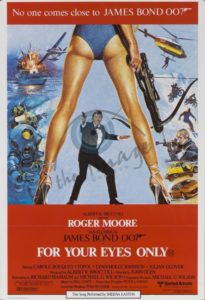 In what seems like a running trend, For Your Eyes Only wasn’t a film I used to gravitate towards as a kid but now I’ve grown to really like it. After the farce of Moonraker, the producers tried to take Bond in a more serious direction and it (mostly) works. Sure, the film ends with Margaret Thatcher on the phone talking to a Parrot she thinks is Bond but the film is more grounded and realistic than the last few films and ends up feeling more similar to the later Timothy Dalton Bond films than any of the other Roger Moore ones. The film features a memorable pre-credits scene, which enforces the bizarre continuity of the Bond canon, and sees Bond visit his dead wife’s grave (a la On Her Majesty’s Secret Service) before surviving a dangerous helicopter journey courtesy of Blofeld who remains unnamed because of legal issues regarding the rights to the character that wouldn’t be cleared up for decades to come. Bond kills “Blofeld” by dropping him down a huge chimney and I really don’t like this scene. Despite the great stunts, it’s such a lacklustre way to bid farewell to the franchise’s lead antagonist. After the rubbish title song and credits, the actual plot begins which concerns the hunt for the ATAC, a MacGuffin computer system that can control all of Britain’s nuclear weapons, which sank someway near Greece. Bond is sent to retrieve the device and stop Greek smugglers, who are in bed with the Russians, from retrieving it, first with the help, and sometimes hindrance, of the revenge-seeking Melina.
In what seems like a running trend, For Your Eyes Only wasn’t a film I used to gravitate towards as a kid but now I’ve grown to really like it. After the farce of Moonraker, the producers tried to take Bond in a more serious direction and it (mostly) works. Sure, the film ends with Margaret Thatcher on the phone talking to a Parrot she thinks is Bond but the film is more grounded and realistic than the last few films and ends up feeling more similar to the later Timothy Dalton Bond films than any of the other Roger Moore ones. The film features a memorable pre-credits scene, which enforces the bizarre continuity of the Bond canon, and sees Bond visit his dead wife’s grave (a la On Her Majesty’s Secret Service) before surviving a dangerous helicopter journey courtesy of Blofeld who remains unnamed because of legal issues regarding the rights to the character that wouldn’t be cleared up for decades to come. Bond kills “Blofeld” by dropping him down a huge chimney and I really don’t like this scene. Despite the great stunts, it’s such a lacklustre way to bid farewell to the franchise’s lead antagonist. After the rubbish title song and credits, the actual plot begins which concerns the hunt for the ATAC, a MacGuffin computer system that can control all of Britain’s nuclear weapons, which sank someway near Greece. Bond is sent to retrieve the device and stop Greek smugglers, who are in bed with the Russians, from retrieving it, first with the help, and sometimes hindrance, of the revenge-seeking Melina.
John Glen, who had previously edited On Her Majesty’s Secret Service, The Spy Who Loved Me and Moonraker, takes over directing duties and would go on to direct all 5 Bond films produced in the 1980’s. Glen balances the hallmarks of Bond very well with great action sequences and comedy that, Thatcher/Parrot scene notwithstanding, fit with the tone. The film succeeds by pulling back on the large scale battles that defined the previous two films and instead deals with smaller and more intense set pieces. The ski chase is probably the highlight of the film, complete with insane stunts like a motorbike chasing a skier down a speedy bobsleigh track and Bill Conti’s soundtrack which is so very 80’s and therefore so very awesome. The film does lose momentum soon after this sequence and slows down a little too much until the fantastic yet understated finale which features a nail-biting scene following Bond climb a cliff face to the hidden base of the villainous Kristatos, portrayed by Julian Glover (and Charles Dance in his film debut as a henchman). The perilous climb is one of my favourite sequences in all of Bond, superbly directed by Glen and featuring very little music; the only soundtrack being the wind, shoes shuffling on bare rock and Moore’s grunts. It’s a quiet and tense scene, which I wish there were more of, and is the epitome of For Your Eyes Only compared to bombastic and silly films of past and future.
Octopussy (1983)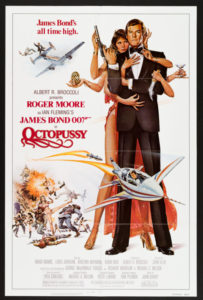
When I was a kid I never used to follow the plots of Bond films, instead finding solace and entertainment in the formula of action, stunts and baddies. Watching Octopussy makes me wish I could revert back to that childlike innocence because the plot makes no sense whatsoever. The first half concerns Bond in India, tracking down Kamal Khan, a wealthy Afghan prince and seller of a fake Fabergé egg along with Octopussy, a jewellery smuggler who also happens to run a circus. The second half then switches direction entirely and sees this circus be ground zero in a would-be atomic explosion, courtesy of Orlov, a rogue Russian General. These smuggling and bomb plotlines just don’t line up together and I had no idea what was going on and who knew what half the time. This is also the film where, when time is most definitely of the essence and a nuclear bomb is mere minutes from detonation, Bond dresses up as a clown. Yes, the more serious direction that For Your Eyes Only tried to take the franchise is tossed away and, while I’m not abject to humour and the occasional silly moment, the film threatens to become a straight-up farce at some points. Thankfully the egregious moments are few and far between but the whole thing just feels bland, from the villains to the plot.
However it has to be said that Roger Moore gives a great performance, possibly his second best after The Spy Who Loved Me, and is clearly having fun now that his contract has ended and he’s getting huge amounts of cash for each Bond film. There was some doubt to whether he would return and the producers screen-tested James Brolin for the role. John Glen returns to direct and pulls off the stunts in spectacular fashion, from the scenes on the train (filmed close to where I live) to the incredible finale that sees a stuntman hanging on to the top of a moving plane and is even better than the similar scene at the beginning of Mission Impossible: Rogue Nation. There is one enjoyable sequence where Bond is being hunted through the jungle by Khan who’s riding an elephant. It was very reminiscent of the classic short story “The Most Dangerous Game” and I would love to see the plot of that book play out with James Bond in a feature film. Indiana Jones and the Temple of Doom, my personal favourite Indy movie, is often maligned for its depiction of India. I don’t think most of the complaints are valid because that film is actively trying to call back to old pulp serials but no such excuse can be reasoned with Octopussy. Some scenes are very problematic and Bond makes a truly painful joke about curry. Octopussy is far from the heights of the Bond series but, without putting too much thought into what’s actually happening, it can be an enjoyable watch. Nothing particularly sticks out at being amazing or awful. I see it as that Roger Moore Bond film that just exists.
A View to a Kill (1985)
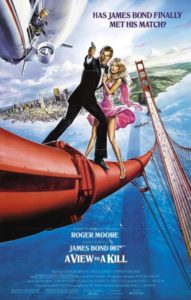 I’ve always liked the idea of an older James Bond. An exploration into what decades of murder, injuries, sleeping around and heavy drinking would do to a person when they had to retire from the profession that required such things. A View to a Kill could have been that film. Moore was certainly of the right age, his advanced years frightfully clear despite having a noticeable facelift since Octopussy. But no. At this point in time there was no stopping the Bond franchise from altering its formula and A View to a Kill resembles yet another post-The Spy Who Loved Me Bond film. This time, Bond is undercover and looking into the dealings of Max Zorin, a genetically-altered German ex-KGB agent who is seeking to destroy Silicon Valley and breeds horses in his spare time. The plot is far too slight to sustain a 130-minute film and everything seems to stop dead several times during the film, most noticeably at the horse sale which is possibly the most boring 30-minute stretch of any Bond film. If not for Christopher Walken’s delightfully strange performance, Zorin would be a pretty bland villain, overshadowed by his henchwoman May Day, portrayed by Grace Jones. Zorin’s relationship with the Nazi scientist who essentially created him could have made for a fascinatingly toxic father/son relationship but sadly we get none of that. Zorin’s most memorable scene comes when he spends several minutes unleashing an Uzi on his own men, laughing manically as he does it, which feels too dark for a Moore-led Bond adventure.
I’ve always liked the idea of an older James Bond. An exploration into what decades of murder, injuries, sleeping around and heavy drinking would do to a person when they had to retire from the profession that required such things. A View to a Kill could have been that film. Moore was certainly of the right age, his advanced years frightfully clear despite having a noticeable facelift since Octopussy. But no. At this point in time there was no stopping the Bond franchise from altering its formula and A View to a Kill resembles yet another post-The Spy Who Loved Me Bond film. This time, Bond is undercover and looking into the dealings of Max Zorin, a genetically-altered German ex-KGB agent who is seeking to destroy Silicon Valley and breeds horses in his spare time. The plot is far too slight to sustain a 130-minute film and everything seems to stop dead several times during the film, most noticeably at the horse sale which is possibly the most boring 30-minute stretch of any Bond film. If not for Christopher Walken’s delightfully strange performance, Zorin would be a pretty bland villain, overshadowed by his henchwoman May Day, portrayed by Grace Jones. Zorin’s relationship with the Nazi scientist who essentially created him could have made for a fascinatingly toxic father/son relationship but sadly we get none of that. Zorin’s most memorable scene comes when he spends several minutes unleashing an Uzi on his own men, laughing manically as he does it, which feels too dark for a Moore-led Bond adventure.
Once again, the tone of the film is all over the place, reaching Moonraker levels of ridiculousness at points. It’s by far one of the very worst Bond films and aspects that could have saved previous films are now a part of the problem. There are no distracting exotic locations, just the French countryside and San Francisco and the recurring character of Gogol is treated very poorly and, despite being the Russian equivalent to M, he spends his time driving his agents around like a taxi service. Moore’s age makes the love scenes quite awkward to watch, whether it’s with Grace Jones or Fiona Fullerton in a hot tub which is one of the worst James Bond scenes of all time. As with many Bond films, the saving graces are the stunt work and John Barry’s music. Duran Duran’s theme song is fantastic and I love when it is melded with Barry’s orchestral score. At one-point Bond saves love interest Stacey from a burning building and it gave me goosebumps. Not because of the scene itself which is a strange homage to Superman but because the music is phenomenal. It’s a shame that Moore, and Lois Maxwell’s Moneypenny, had this film as their swansong and that they couldn’t go out on an “All Time High” but even at their worst there’s enjoyment to be had from every James Bond film.
While there are fun moments and sequences within Moore’s final two Bond films, I wish For Your Eyes Only was his last. The more serious tone that film developed could have been continued by Dalton immediately afterwards and he could have done a couple more films than just the two he eventually filmed. Dalton will be the next article however and I’m excited to revisit his unique era of the franchise. As for Roger Moore, when I started rewatching his films I was still on the high of rediscovering my love for Connery’s Bond and my childhood opinion of Moore as my favourite seemed unequivocally changed. Yet now, 7 films later, and despite or maybe even because of the silliness of his last couple of films, I do still hold Roger Moore as my favourite of the Bond actors and I find his films to be the most entertaining to watch, even if they are objectively far from the best. What are your feelings towards Moore as Bond? How do you like this era of the franchise? Let me know in the comments and geek out with me about TV, movies and video-games on Twitter @kylebrrtt.




